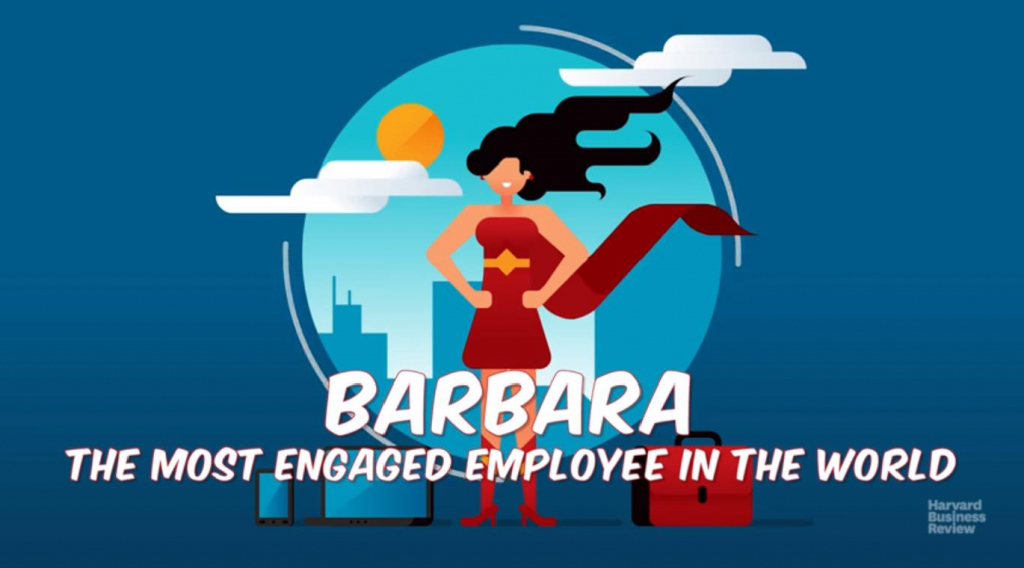OK, maybe it’s a dog, but I definitely have a pet. And a side hustle. Oh, and I kinda look like a super hero.
Because by all measures, I am THE MOST ENGAGED EMPLOYEE in the world!
Or rather, I was very much like her – a composite called Barbara – until my side hustle grew into a business and I had a few kids.

According to research conducted by a few other superheroes trying to save the business world from mediocre performance – Marcus Buckingham, Head of the ADP Research Institute, and Ashley Goodall, Senior VP of Leadership & Team Intelligence for Cisco – highly engaged employees have several things in common. And I checked all the boxes when I worked in the corporate world:
While some of these qualities have changed since I started my own company, I still consider myself to be a highly engaged employee, just in service to my clients’ organizations.
And I am endlessly fascinated by engaged employees in general because I have seen and experienced firsthand the difference they make in their organizations. Which is why I factor the opportunity for employee engagement – literally – into every project MiddleWay takes on.
So it goes without saying that I am thrilled the data exists to validate my experience.
What’s good for the employee is good for the employer
Engagement is not only good for employees: it’s critical to organizational success. Why?
Because disengaged employees cost U.S. companies up to $550 billion a year due to:
The worse news: only 16% of employees are fully engaged; 84% are “just coming to work.”
And the tried and true management practices of yesterday based on “command and control” tactics –annual performance reviews, arbitrary rankings and archaic competency models – no longer inspire performance across today’s modern workforce. Additionally, while perks and benefits are nice, employees want purpose and potential for growth, not just a paycheck.
The better news: organizations can do a lot to boost engagement and transform their companies into places of purpose, potential and profitability. Those that do outperform companies with low employee engagement by 202% across a host of metrics.
We’re Coming to Get You, Barbara
So we need more of Barbara’s moxie in our manpower. Where do we start? Buckingham and Goodall suggest a bunch of strategies to move the needle on engagement including:
I want to give a quick shout out to their latest book – Nine Lies About Work – that covers off on these topics and more, and offers an eye-opening perspective on how we can improve organizational performance and better support our people. Check it out with confidence, knowing I have no ties – affiliate or otherwise – beyond a healthy appreciation for their work : )
What colored me Barbara back in the day?
To begin with, I was given the latitude and trusted – no encouraged, supported and provoked – to grow and use my talents to do audacious, crazy things. Like making quirky videos starring my colleagues sharing our value story and showing their unique personalities to accompany client bids. Or dreaming up big themes and even bigger creative experiences for client and employee events – including one featuring a rock band and custom theme song to launch our new internal culture.
But if I had to boil it down, it was being a part of something larger than myself, and feeling a sense of purpose and teamwork with my colleagues. We were all laser focused on the same thing: exceptional customer service, supporting each other in delivering it and contributing to a joyous, empowering culture that celebrated it whenever we saw it.
That last piece is probably critical given that a full 75% of employees agree their company culture determines their active engagement at work; however, less than one third feel their companies have a strong culture.
If culture eats strategy for lunch, then employee engagement is our just desserts
And one of the Marketing’s most powerful, not-so-secret weapons.
We need our people to be more engaged than ever, particularly since the buyer’s journey evolved from a nice, tidy funnel to an ever expanding, self-serve smorgasbord of branding and information touch points. Because we need content. Lots of it. And really great, on-point content our customers want.
Guess where we can source this stuff? Through the people in our organizations – both those working directly with our customers and in supporting roles whose work contributes to the products and services we provide.
In other words, we have super heroes stationed across our companies. But we’re not giving them enough opportunities to wear their capes or let their freak flags fly.
Marketing can change that.
We can create a rotational “gig culture” that promotes engagement by:
Because if it’s our job to help bring in new customers and keep the ones we have in ongoing state of delight, employee engagement is the key to getting it done – particularly for B2B service-based organizations.
Bottom line: if our people are not engaged and can’t deliver on the value story we tell, all of the most brilliant top of funnel marketing campaigns in the world will not help us grow and sustain a successful business that makes a real difference in the lives of our people and our customers.